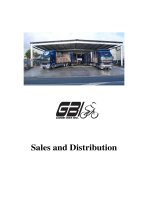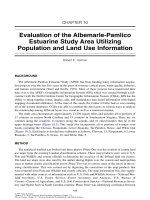Lecture Sales and distribution management: Chapter 10 - Krishna K Havaldar, Vasant M Cavale
Bạn đang xem bản rút gọn của tài liệu. Xem và tải ngay bản đầy đủ của tài liệu tại đây (353.94 KB, 39 trang )
Chapter
10
Channel Institutions - Retailing
SDM Ch 10
Tata McGraw Hill
1
Learning Objectives
•
•
•
•
•
•
•
•
•
Understand what retailing is all about
Global retail scene and trends
Indian retail scene and trends
Types of retailers
Trade and retail formats, trading area
Retail management strategies and operations
Measuring retail performance
Franchising and e-tailing
FDI in retail in India
SDM Ch 10
Tata McGraw Hill
2
What is Retailing?
• Any business entity selling to consumers
directly is retailing – in a shop, in person, by
mail, on the internet, telephone or a vending
machine
• Retail also has a life cycle – newer forms of
retail come to replace the older ones – the
corner grocer may change to a supermarket
• Includes all activities involved in selling or
renting products or services to consumers for
their home or personal consumption
SDM Ch 10
Tata McGraw Hill
3
Retailing
• Term retail derived from French word
‘retaillier’ meaning ‘to break bulk’
• Characteristics:
– Order sizes tend to be small but many
– Caters to a wide variety of customers. Keeps a
large assortment of goods
– Lot of buying in the outlet is ‘impulse’- inventory
management is critical
– Selling personnel and displays are important
elements of the selling process
– Strengths in ‘availability’ and ‘visibility’
– Targeted customer mix decides the marketing mix
of the retailer
SDM Ch 10
Tata McGraw Hill
4
Retailing
• Retail stores are independent of the
producers – not attached to any of them
• A survey shows that only 35% of
supermarket purchases are preplanned. The rest are ‘impulse’- greatly
influenced by quality of the
merchandising efforts
SDM Ch 10
Tata McGraw Hill
5
Functions of Retailers
• Marketing functions to provide
consumers a wide variety
• Helps create time, place and
possession utilities
• May add form utility (alteration of a
trouser bought by a customer)
• Helps create an ‘image’ for the products
he sells
SDM Ch 10
Tata McGraw Hill
6
Functions of Retailers
• Add value through:
– Additional services – extended store
timings, credit, home delivery
– Personnel to identify and solve customer
problems
– Location in a bazaar to facilitate
comparison shopping
SDM Ch 10
Tata McGraw Hill
7
How do Customers Decide on
a Retailer?
•
•
•
•
•
•
Price
Location
Product selection
Fairness in dealings
Friendly sales people
Specialized services provided
SDM Ch 10
Tata McGraw Hill
8
Kinds of Retailers
Type of
retailer
Characteristics
Specialty store
Narrow product line with deep assortment – apparel,
furniture, books
Department
store
Several product line in different departments – Shoppers
Stop, Big Bazaar
Supermarket
Large, low-cost, low-margin, high volume, self-service
operation with a wide offering
Convenience
store
Small stores in residential areas, open long hours all
days of the week – limited variety of fast moving
products like groceries, food
Discount store
Standard merchandise sold at lower prices for low
margins - Subhiksha
SDM Ch 10
Tata McGraw Hill
9
Kinds of Retailers
Type of
retailer
Characteristics
Corporate
chains
More outlets owned and controlled by one firm – Globus
Voluntary chain
Wholesaler sponsored group of independent retailers
Retailer co-ops
Independent retailers with centralized buying operations
and common promotions
Consumer coops
Co-op societies of groups of consumers operating their
own stores – farmers, industrial workers etc
Franchise
organisation
Contractual arrangement between the producer and
retailers – selling products exclusively – Kemp Toys
SDM Ch 10
Tata McGraw Hill
10
Retailing Scene - Global
• Well organised in most developing countries
• Global biz worth about $ 6.6 trillion
• Retail market size is $2325 bln in the US and
$ 280 bln in India.
• Organised retail is 85% in the US and about
5% in India. China 20% Taiwan 80%
• Retail sector is part of the service sector and
if organised, is a major contributor to a
country’s GDP
SDM Ch 10
Tata McGraw Hill
11
Retailing Scene - Global
• High potential for generating employment – 2
mln retail outlets in the US employ about 22
mln people
• Retail sector contributes significantly to the
growth of the economy
• Organised retail is becoming powerful over its
suppliers (who may also be big corporates)
• Producers of goods taking action to protect
their turf
SDM Ch 10
Tata McGraw Hill
12
Retailers’ Strengths
• Choice of merchandise is their prerogative –
put pressure on producer suppliers
• Many new products on offer. Can charge
penalty if products do not do well
• New developments in IT help them run
operations optimally and keep track of loyal
customers. Also helps them identify profitable
store locations.
SDM Ch 10
Tata McGraw Hill
13
The Indian Retail Scene
SDM Ch 10
Tata McGraw Hill
14
Salient Features
• Estimated over 12 mln retail outlets with
most of them in the unorganized sector
• 10 outlets per 1000 population
• Average per capita space – 2 sq ft
compared to 15 sq ft in the US
• Organized retail is estimated between 4
to 7% but growing fast
SDM Ch 10
Tata McGraw Hill
15
Organized Retail
• Growing trends attracting global players
• Some of them like Wal Mart and Tesco have
already created buying hubs here.
• In Jan 2006, GOI has permitted FDI upto 51%
in single brand retail outlets
• Well known brands like Marks & Spencer,
Reebok, Levis, Adidas, Nike, Reebok,
McDonalds, KFC, Swarowski are already in
India.
SDM Ch 10
Tata McGraw Hill
16
Organized Retail - Features
• Sponsored by companies or corporate groups
• Large formats like supermarkets, department
stores and now hypermarkets
• Right ambience to make shopping a pleasure
• Use latest technology for customer care and
supply chain management.
• Large employment potential
• Effectively manage operating costs
• Offer consumers value for money
SDM Ch 10
Tata McGraw Hill
17
Retailing Trends - India
• Consumer wants more benefits without
additional costs
• Rising income levels – cheap no longer
works, but ‘value for money’
• Explosion of communication channels
influences choices of products
• Increased literacy has made consumer more
conscious of his bargaining power
• Growing number of urban nuclear families
SDM Ch 10
Tata McGraw Hill
18
Retailing Trends - India
• Influence of retailer increasing – assortment
plus other facilities offered
• Rural consumers want the same things and
as their urban counterparts and are willing to
pay for it
• Better organized supply chains to cater to a
large number of outlets in different locations
• Improved infrastructure helping the
consumers
• Bigger volumes help in economies of scale
SDM Ch 10
Tata McGraw Hill
19
FDI in Retail in India
• MNC players showing interest to operate in
India
• Resistance from the existing players
• So far only cash-and-carry permitted
• Franchisees also allowed – KFC, Tag Heuer,
Swatch, McDonalds
• Jan 2006, 51% FDI permitted in single brand
businesses:
– All products should be under the same brand
name
– Same brands should be sold internationally
– Branding at the time of manufacturing itself
SDM Ch 10
Tata McGraw Hill
20
Trade / Retail Format
• Range of goods and customer service
dimensions determine the ‘format’. Elements
distinguish between stores and include:
– Store ambience. (Kemp Fort)
– Saving in time for shopping – interiors of practical
design – reduce time for search and pick-up of
goods
– Location
– Physical characteristics – external appearance,
arrangement of goods
• All these are parts of the positioning strategy
and influence the ‘footfalls’ to the store.
SDM Ch 10
Tata McGraw Hill
21
Categories of Shoppers (1)
• Identified by Cook & Walters
• Task focused shopper – visits the store to buy
specific things he has planned for
– Convenience, minimum time, easily accessible
goods, pleasing store format
– Grocery shopping is an example
• Leisure shopper – more interested in the
ambience and environment
– Has plenty of time, wants to have a good time
while shopping
– Lifestyle stores are examples
SDM Ch 10
Tata McGraw Hill
22
Category of Shoppers (2)
• Convenience goods (low value): probable
gain from shopping and making comparisons
is small compared to the time, effort and
mental discomfort required in the search
-toothpaste
• Shopping goods (high value): gain is large refrigerator
• Specialty goods: clearly distinguished by
brand preferences – Maruti Zen car or TagHeuer watch
SDM Ch 10
Tata McGraw Hill
Trading area…
23
Trading Area
• Catchment area from where most of the
customers of a retail store come
– Corner grocery store caters to the locality in which
it is situated
– Discount stores have a wider area. Subhiksha
locations for consumers in 2 km radius
– Specialty stores have a much wider trading area –
MTR, Shoppers’ Stop etc
• Trading area increases with the size of the
store and the variety it offers
SDM Ch 10
Tata McGraw Hill
24
Retail Strategy
•
•
•
•
Positioning of the retailer
Merchandising
Customer service
Customer communication
SDM Ch 10
Tata McGraw Hill
25









